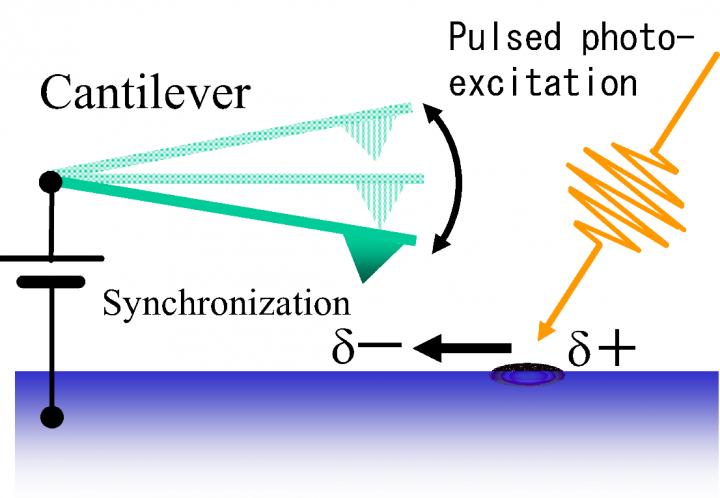High-speed surveillance in solar cells catches recombination red-handed

This is a schematic diagram illustrating the principle of tip-synchronized time-resolved electrostatic force microscopy. Credit: Osaka University
A research team at Osaka University has developed an improved method for producing microscope images that can spot speedy electrons zipping through nanomaterials used in solar panels.
By applying laser light to the device at just the right times, this group achieved nanosecond time resolution for the first time while maintaining the magnification. This work could improve the quality of photovoltaic materials for devices such as solar panels by helping to identify and eliminate inefficiencies during the manufacturing process.
Surveillance cameras are ubiquitous, and extremely valuable to the police when trying to catch thieves. However, cameras that record only a single movie frame per minute would be useless for apprehending speedy robbers who can make their getaway in less than sixty seconds.
Solar panels harness the power of the sun when electrons become excited to a higher energy level, leaving a void, or “hole”, behind. However, if an electron recombines with a hole before reaching the electrode, the harvested energy is lost, “robbing” the device of critical efficiency.
Currently available microscopy methods are too slow to catch the miscreants in the act. So the team at Osaka used electrostatic force microscopy (EFM), in which a tiny, vibrating cantilever tip is made sensitive to electric charges passing beneath it.
EFM is still usually too slow to watch electrons and holes in motion, but their key innovation was to apply synchronized laser pulses that hit the sample at the same point of the cantilever's oscillation. By altering the delay time between the start of the cycle and the laser pulse, they were able to create a movie with frames as fast as 300 nanoseconds. “This is the first time anyone was able to combine nanosecond time resolution without sacrificing magnification,” said lead author Kento Araki.
When the researchers probed the “scene of the crime”, they were able to obtain video evidence of recombination as it was occurring. This method may be extremely useful for designing more efficient solar panels by reducing the energy losses due to recombination. According to senior author Takuya Matsumoto, “the research is also potentially useful for the study of catalysts or batteries that depend on light activation.”
###
The article, “Time-resolved electrostatic force microscopy using tip-synchronized charge generation with pulsed laser excitation” was published in Communications Physics at DOI: https:/
About Osaka University
Osaka University was founded in 1931 as one of the seven imperial universities of Japan and now has expanded to one of Japan's leading comprehensive universities. The University has now embarked on open research revolution from a position as Japan's most innovative university and among the most innovative institutions in the world according to Reuters 2015 Top 100 Innovative Universities and the Nature Index Innovation 2017. The university's ability to innovate from the stage of fundamental research through the creation of useful technology with economic impact stems from its broad disciplinary spectrum. Website: https:/
Media Contact
All latest news from the category: Power and Electrical Engineering
This topic covers issues related to energy generation, conversion, transportation and consumption and how the industry is addressing the challenge of energy efficiency in general.
innovations-report provides in-depth and informative reports and articles on subjects ranging from wind energy, fuel cell technology, solar energy, geothermal energy, petroleum, gas, nuclear engineering, alternative energy and energy efficiency to fusion, hydrogen and superconductor technologies.
Newest articles

A ‘language’ for ML models to predict nanopore properties
A large number of 2D materials like graphene can have nanopores – small holes formed by missing atoms through which foreign substances can pass. The properties of these nanopores dictate many…

Clinically validated, wearable ultrasound patch
… for continuous blood pressure monitoring. A team of researchers at the University of California San Diego has developed a new and improved wearable ultrasound patch for continuous and noninvasive…

A new puzzle piece for string theory research
Dr. Ksenia Fedosova from the Cluster of Excellence Mathematics Münster, along with an international research team, has proven a conjecture in string theory that physicists had proposed regarding certain equations….



